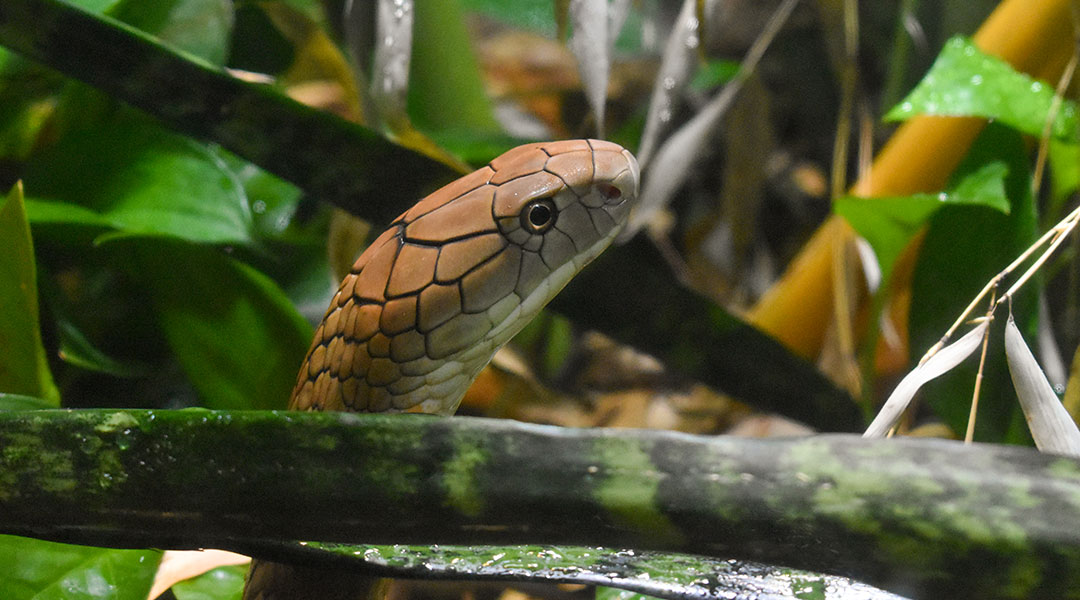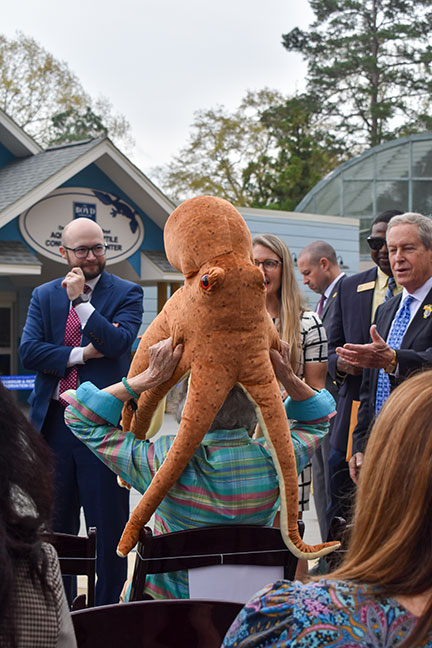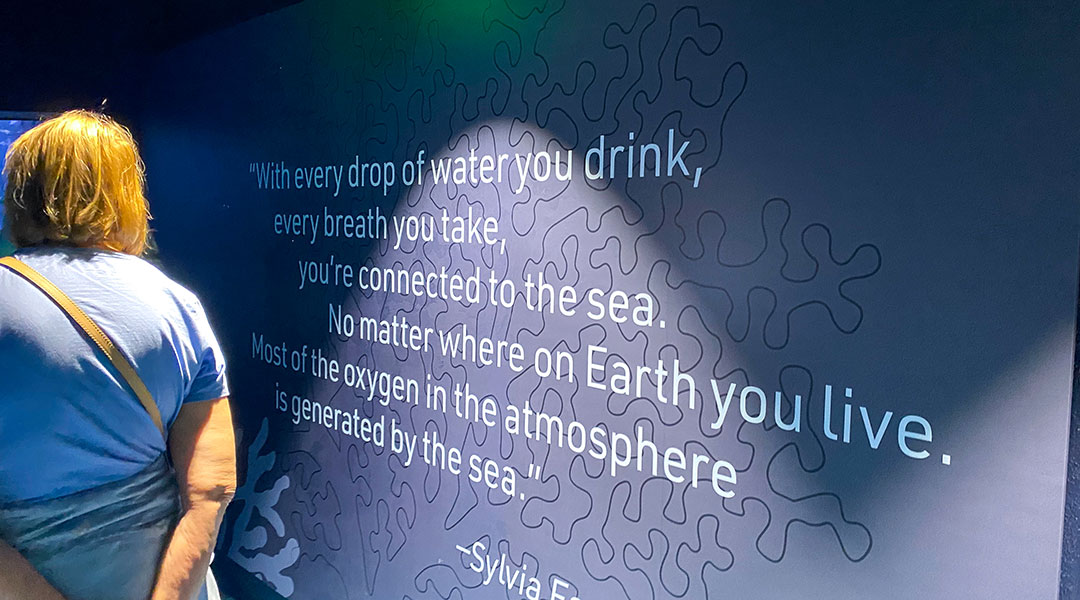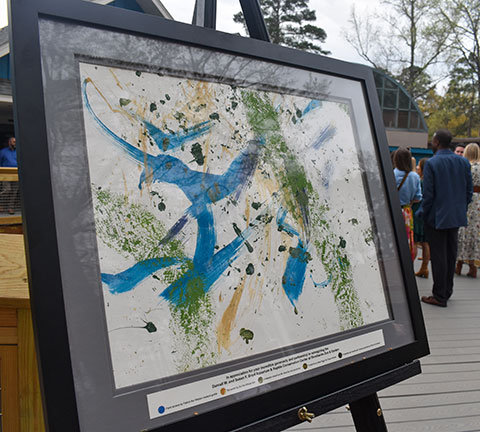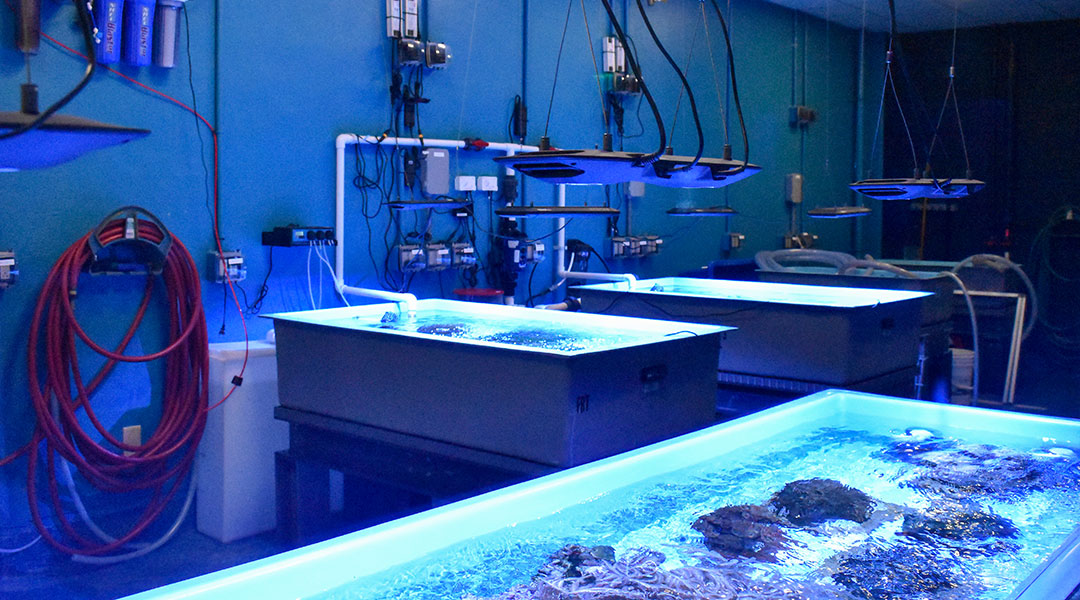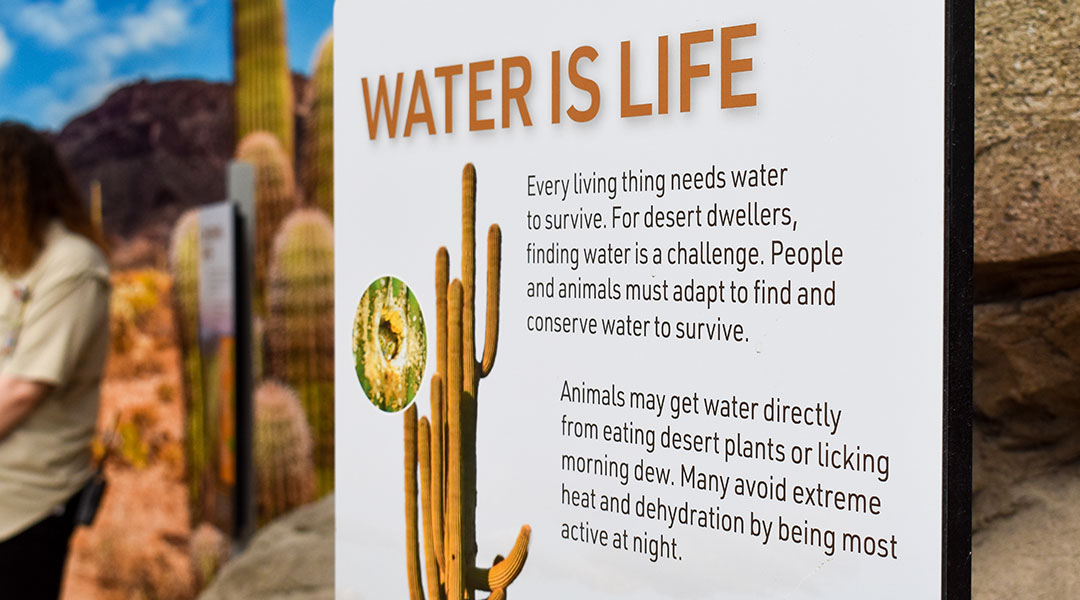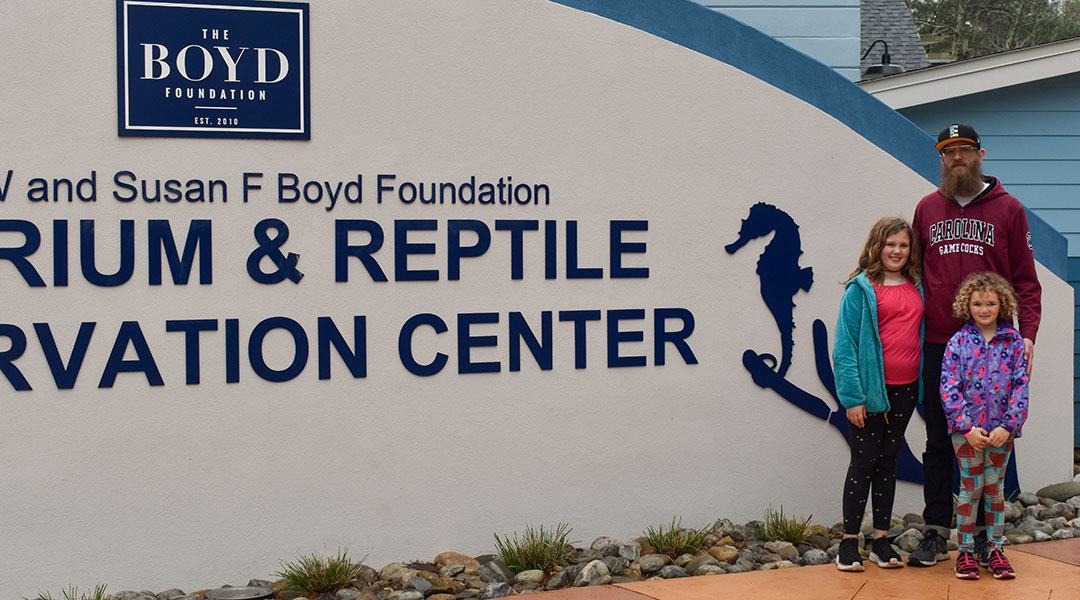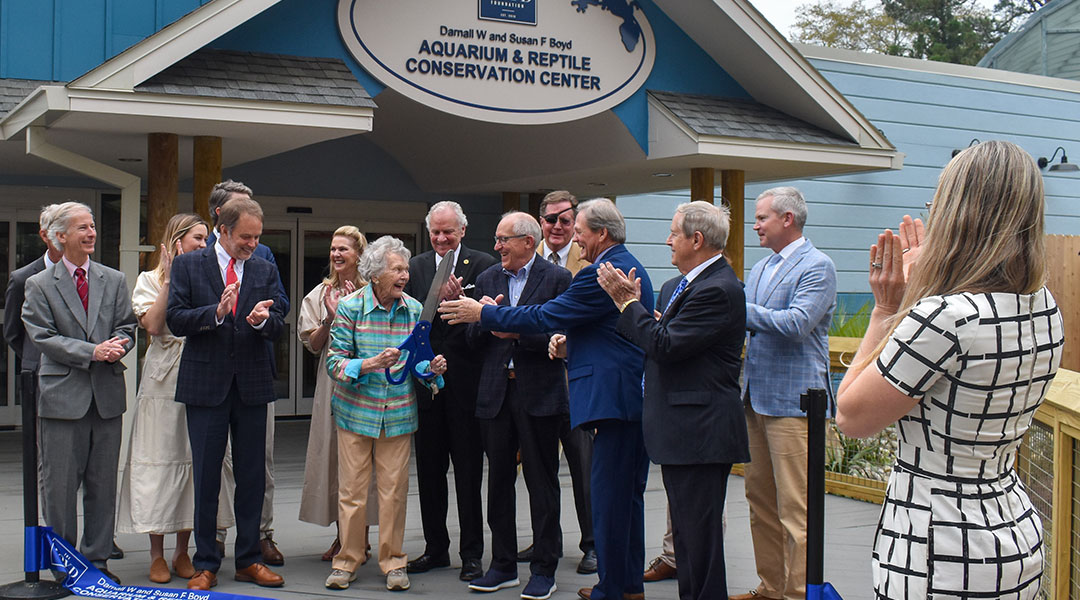The Aquarium and Reptile Conservation Center features more than 8,000 animals of all shapes and sizes. The center is now open for guests to visit. (Photos by Emily Okon. See photo gallery below.)
The wall of the ocean habitat in the Aquarium and Reptile Conservation Center at Riverbanks Zoo is painted with a quote from American marine biologist Sylvia Earle.
“With every drop of water you drink, every breath you take, you’re connected to the sea,” the quote reads.
The zoo held its opening ceremony of the new conservation center March 2 after nearly two years of construction.
“This has been quite an amazing trip over the last year and a half,” said Sean Foley, a reptile specialist at Riverbanks. “We’ve been introducing animals over the last month or so, and that’s been super exciting. They’re enjoying their new exhibits, and it’s just been an incredible experience.”
Guests will walk through the doors and into a temperate forest biome, the biome most common in the Palmetto State.
Guests also will experience the temperate forest, life on the ocean floor and the newly added desert biome as they move through the building.
The conservation center will host more than 8,000 animals once they’ve arrived at their new homes.
Animals of all sizes and species will be featured, including jellyfish, parrots and a giant Pacific octopus by the name of Susan.
Susan the octopus is named in honor of Susan F. Boyd, director of the Darnall W. and Susan F. Boyd Foundation.
The Boyd Foundation has funded and sponsored projects across the Midlands, including Boyd Plaza at the Columbia Museum of Art and Boyd Island at the Saluda Riverwalk.
The conservation center’s renovation was only possible with the help and funding the Boyds provided.
“This is one of those places where people are going to get to come back for that second visit and really be wowed just as much as the first time,” said Lochlan Wooten, the chief operating officer of Riverbanks.
Conserve and protect
Riverbanks’ desire to promote conservation education in the Palmetto State was the driving factor behind the new center, Wooten said.
“For people to care, they need to understand, and it is our job to help people understand why diversity matters,” Wooten said. “And then get them to care enough to do it.”
One of the many additions made to the ARCC is the coral reef conservation lab that is now viewable to any guest who walks the halls.
Coral reef conservation is not a new thing at Riverbanks. It was simply hidden from the public eye.
“A lot of our conservation efforts with particular animals happened in the back areas, so a lot of people didn’t get to actually experience that or see that,” Foley said. “Now we’re bringing that forward to the public and to our visitors, which is a great experience.”
The lab showcases colonies of coral that were rescued near Key West after a disease outbreak affected more than half of the coral reefs off the coast of Florida.
Stony coral tissue-loss disease was first reported in 2014 and has since spread across the Floridian reef tract, a coral reef that spans about 360 miles.
“We’re really highlighting the importance of coral reefs because while they’re only 1% of the planet, they contain so much biodiversity,” Wooten said. “Protecting those coral reefs is critical. … You’ll get to see how Riverbanks is directly caring for endangered coral.”
Riverbanks partnered with local Florida governments and other zoological institutions to aid in the restoration efforts.
Riverbanks is working to conserve other species, too.
Guests are able to view a terrestrial lab where zookeepers care for endangered populations of geckos from around the world and meet Destiny, the green sea turtle.
Destiny, who was found on the beach by the S.C. Department of Natural Resources, arrived at Riverbanks Zoo not too long after the turtle’s birth.
Riverbanks has been protecting the endangered green sea turtle species for years. It partners with the agency to rehabilitate rescued sea turtles and release them back into the wild.
Destiny will soon be returning to the sea.
“Then DNR will bring us another hatchling, and we’ll give that one a head start in life,” Wooten said.
Impacts on the Palmetto State
Riverbanks has not lost track of its roots through its expansion.
The conservation center includes plenty of S.C. native species, including ones found in Columbians’ backyards.
Dwarf sirens, three-toed amphibians, are local to South Carolina and are on exhibit in the new center.
But Riverbanks isn’t just aiming to showcase state animals. They’re also trying to save them.
The Carolina gopher frog is found in the Atlantic coastal plains of the Carolinas.
The species has been marked “at-risk” by the U.S. Department of Agriculture and is now under the protection of the Endangered Species Act.
“We’re trying to get some of those (gopher frog) tadpoles on exhibit,” Foley said.
Visitors might be affected just as much as the animals.
The Ureda family has been coming to the zoo since their father, Kent Ureda, was a child. From zoo camps to monthly visits, the zoo has educated each of the Ureda children.
The two oldest children, Lucille, 10, and Artemis, 6, are avid lovers of the zoo.
“I really like being able to go behind the scenes and learning about the different animals and stuff,” Lucille said.
Both of the girls have been participating in zoo camps for as long as they can remember.
“I’ve always loved learning,” Ureda said. “And whenever Jeopardy comes on, if there’s an animal category, we’ll clear it out.”
Wooten and her staff love seeing both the reactions of parents and children.
“Environmental education is the heart of what we do,” Wooten said.
Looking forward
Bridge to the Wild is a three-phase renovation project at Riverbanks that began in 2020 with the introduction of a white rhino exhibit.
The grand opening of the ARCC marks the completion of part two of the first phase of Bridge to the Wild.
The next phase will embrace the local environment with an S.C. nature preserve riverwalk. The riverwalk will run along the Saluda River and Riverbanks Zoo.
It’s “a one-of-a-kind, spectacular opportunity to give more access to the river, which is such a unique feature in Columbia and something that we all need to be working to really highlight,” Wooten said.
Bridge to the Wild isn’t over just yet. The renovations could take years before they’re complete, Wooten said.
The ARCC’s opening day featured hundreds of animals for guests to experience and learn about. But there were a few animals missing in action.
Susan, the giant Pacific octopus, has yet to settle into her new home. But zookeepers ensure that she is on the way.
“The exhibit is still being prepared for her arrival, and it’ll probably be a number of weeks,” said Aquarium Curator Jennifer Rawlings. “It takes a while to condition the water once we can get it (the animal) into the exhibit. … I’m really excited to have her here one day.”
The aquarium also is expecting a few other animals to arrive in the coming weeks.
A new octopus will be arriving at Riverbanks in the coming weeks and its name will be Susan, named after the director of the Boyd foundation. The zoo gave a stuffed octopus to Boyd on opening day.
The ARCC features two quotes from esteemed environmentalists, including Sylvia Earle. Earle is an American marine biologist who broke a record for walking on the ocean floor untethered for 2.5 hours.
This painting was created by Patrick the gorilla, Zuri the lion, Mr. Boa the boa constrictor, Miss Piggy the tortoise and Remy the lorikeet.
Riverbanks is saving Floridian coral reefs one small bit at a time.
ARCC features a viewable laboratory where the animal care team simulates an oceanic environment.
The desert biome is new to the ARCC. Guests can find parrots, iguanas, rattlesnakes and tortoises in the desert room.
Kent Ureda and two of his children, Lucille and Artemis, pose outside of a place they call home. The Ureda family has been coming to the zoo for more than 10 years.
Lucille and Artemis pose as a giraffe and sea lion after their father told them to mimic their favorite animals.

